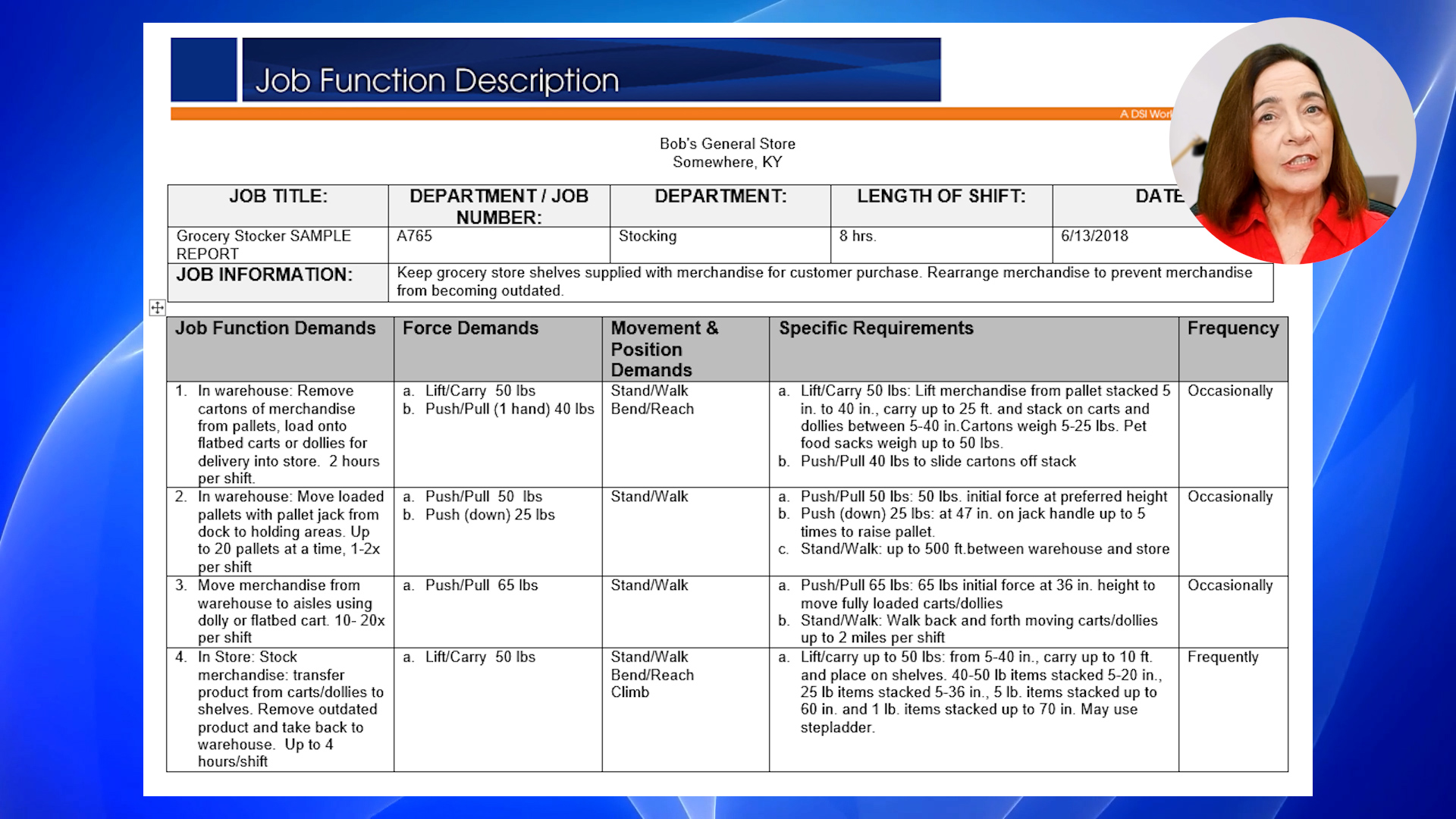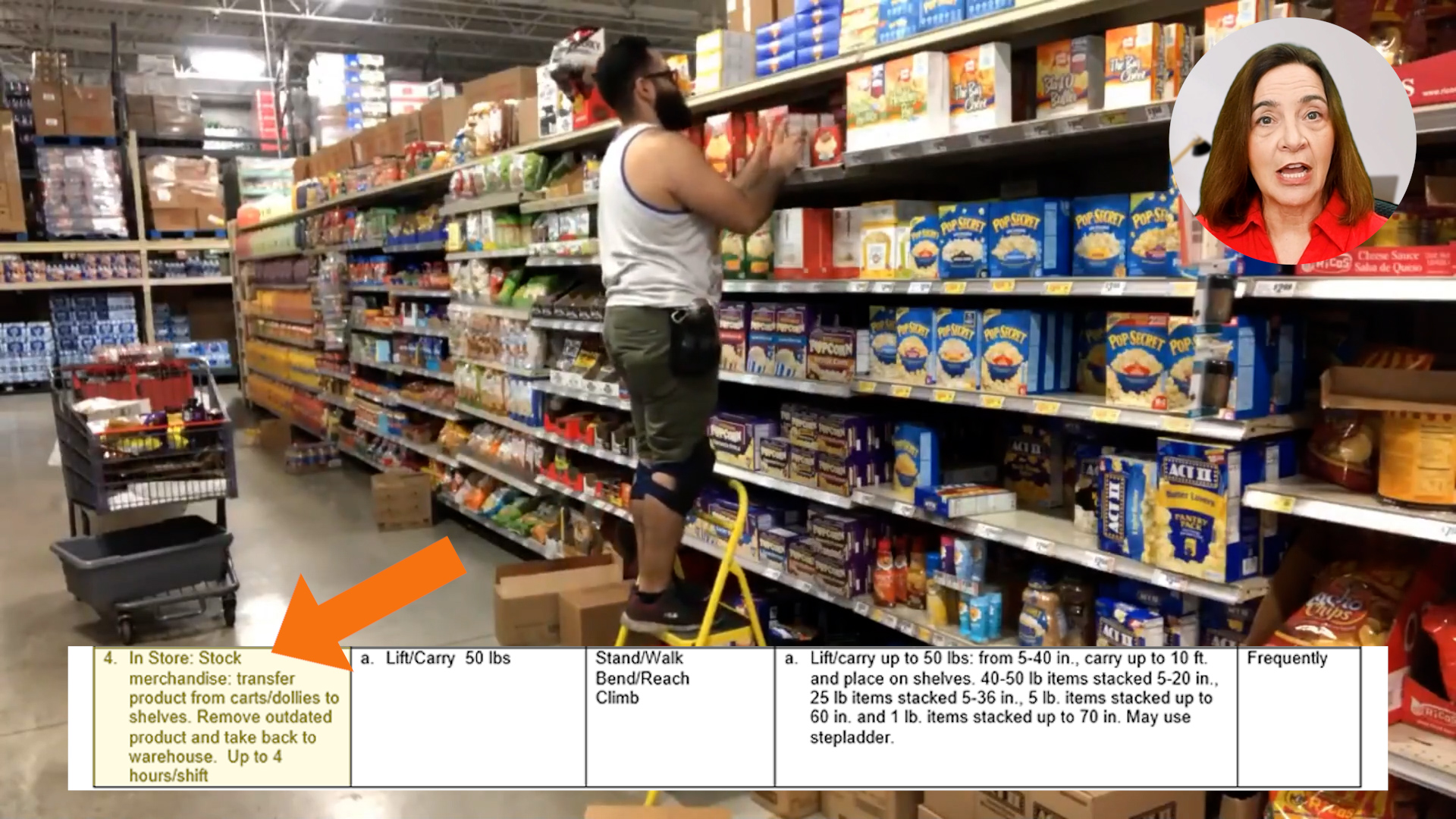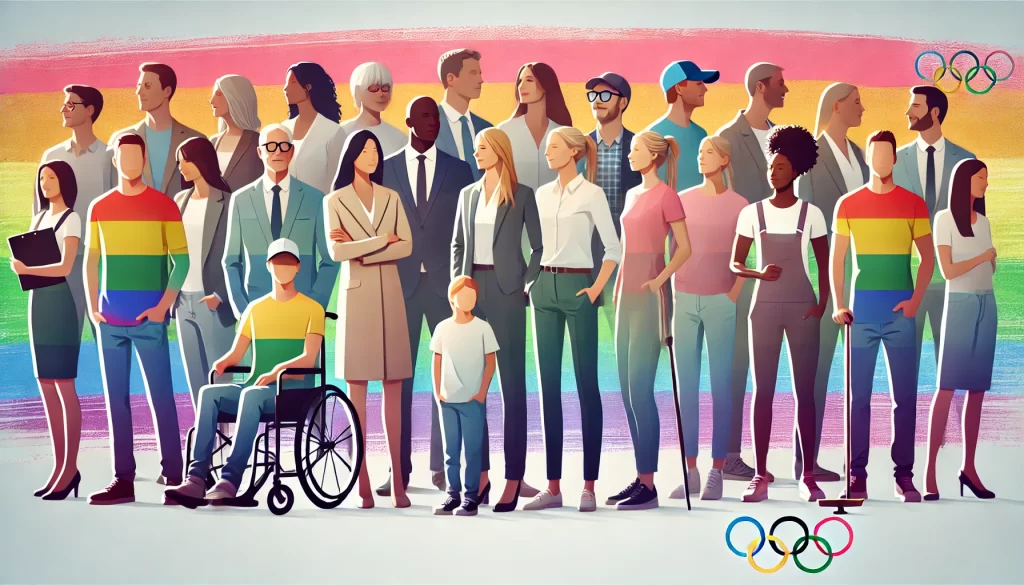Introduction
Function-based job analysis plays a pivotal role in enhancing workplace safety, a great supporting role for those in the fields of physical therapy, occupational therapy, athletic training and other professionals with workplace safety responsibilities. In our recent video series, we explored the impact of job analysis on injury prevention and management. Here, we dive deeper into job function matching, offering practical insights to help professionals apply these concepts effectively in work environments. As we navigate this topic, our goal is to provide you with some of the tools and understanding necessary for optimizing workplace safety and therefore employee well-being.
The Importance of Job Analysis
Job analysis stands as a fundamental tool in preventing and managing workplace injuries, serving as a bridge between what a job requires from a physical demands perspective and the capabilities of an employee. Job analysis is a tool that helps create environments that not only prevent injuries but also foster quicker, more effective recovery and return to work when an employee experiences an injury or illness. By systematically evaluating job demands, injury prevention programs can be tailored, plus training and even rehabilitation plans can be specifically aligned with the physical requirements of jobs.
The essence of job analysis lies in its objective approach – it’s about dealing with facts rather than perceptions. An objective, fact-based job analysis methodically assesses each aspect of a job, from functional requirements to physical demands, ensuring that recommendations are grounded in objective data. This contrasts sharply with subjective, opinion-based methods, which rely on personal experiences, judgements and assumptions. This type of job analysis leads to more accurate, reliable, and applicable solutions in musculoskeletal safety, where the impact of solutions can be measured, making job analysis an invaluable asset.

Documentation and Its Critical Role
The way job analysis results are documented is critical in bridging the gap between theoretical analysis and practical application. Clear, concise, and comprehensive documentation serves as a tangible guide for employers, therapists, and employees. It translates the complexities of job function demands into actionable insights, making it easier for employers to understand the specific needs and limitations of their employees. This clarity is essential, especially when adapting work roles to accommodate employees returning from injuries.
Well-documented job analysis not only facilitates a better understanding but also streamlines the return-to-work process. It provides a roadmap for employers to implement effective work modifications, ensuring that the tasks assigned are within the injured employee’s capabilities. This approach minimizes the risk of re-injury and aids in a smoother, more efficient transition back to work. In essence, effective documentation acts as a crucial tool in injury management, fostering a workplace environment that prioritizes employee health and safety while maintaining operational efficiency.
Real-World Application: A Case Study
Consider the role of a grocery stocker, a familiar job to many. This example illustrates the practical application of job analysis. When an employee in this role faces an injury, resulting in restrictions such as no lifting over 25 pounds, or no work above shoulder level, job analysis documentation becomes vital. It provides a clear, objective understanding of the job’s physical demands and communicates these clearly to the employee and employer representatives with a need to know.
This documentation aids significantly in interpreting work restrictions. That alone can be a huge factor in reducing days away from work and restricted work days. For instance, it can clarify whether an injured stocker can perform certain job functions within the work restrictions. By detailing each job function demand –such as transporting merchandise or stocking shelves – and correlating them with the employee’s work restrictions, there is more informed decision-making and better communication of work activities that are allowed. This approach not only helps in tailoring the employee’s duties to fit their work restrictions but also ensures that their return to work is safe and effective. It’s a process that balances the needs of the employee with the operational requirements of the employer, and it facilitates a smoother transition back to work.

Interpreting Job Function Demands
In the grocery stocker scenario, analyzing job function demands involves a detailed breakdown of each job function associated with the role. For instance, we examine activities like removing cartons from pallets, using pallet jacks, and stocking shelves. Each of these functions has unique physical requirements – lifting, push/pull forces and reaching heights. With this documentation in hand, an employee’s work restrictions or actually demonstrated functional abilities can be compared. For example, does an employee’s current medical restriction of lifting no more than 25 pounds allow them to stock shelves?
Interpreting work restrictions within the context of job demands is a critical step. It involves matching the physical requirements of each job function to the work restrictions of the employee. This process ensures that the employee is not assigned tasks that exceed their current work restrictions or physical capabilities. For example, if the job demands include lifting items heavier than 25 pounds, those tasks would be off-limits for an employee with such a lifting restriction, or considered for modification. By systematically evaluating each job function demand in this manner, we ensure that work assignments are not only compliant with medical advice but also conducive to the employee’s recovery and long-term well-being.
The Role of Testing in Job Matching
Testing is a pivotal component in the process of job matching, serving as a means to accurately determine an employee’s capabilities. This step goes beyond traditional job analysis by involving actual physical assessments. These assessments are designed to measure an employee’s strength, flexibility, endurance, and other relevant physical attributes. By conducting these tests, we obtain job specific objective data about what an employee can safely handle in terms of job demands. This approach is especially valuable when matching employees with specific job roles or when reintegrating them into their positions following an injury. This can substantially reduce lost days, restricted days and costs associated with work injury management.
This methodology is beneficial for both the employee and the employer. For the employee, it provides a clear understanding of their physical abilities and limitations, ensuring that they are matched with job functions that they can perform safely and effectively. For the employer, it offers assurance that the employee’s placement is appropriate, minimizing the risk of re-injury and enhancing overall workplace productivity. Testing, therefore, is not just about finding a fit for the employee in the workplace; it’s about creating a harmonious balance where the employee’s capabilities and the job’s requirements are aligned, ensuring a safe, efficient, and productive work environment.

Conclusion
I warmly invite you to delve deeper into the realm of job analysis by exploring our website. Each course we offer is meticulously designed to not only enhance your understanding but also to refine your application of these essential concepts in the field of work injury prevention and management. As you navigate through our site, you’ll find a treasure trove of resources at your fingertips, and we provide you with the opportunity to experience the first lesson of our courses without any obligation. Our goal is to equip you with education and support that bolsters your success and proficiency in managing and preventing work injuries.
I sincerely hope you’ll continue to join us for the next five videos in our informative series. This journey isn’t just about acquiring knowledge; it’s about playing an active role in fostering safer and more efficient work environments. Together, professionals across various fields, including human resources, safety, healthcare, and beyond, can create a more significant impact. Let’s embark on this journey together, striving for excellence in work injury management and prevention, and contributing to a safer and more productive workplace for all.












.webp)